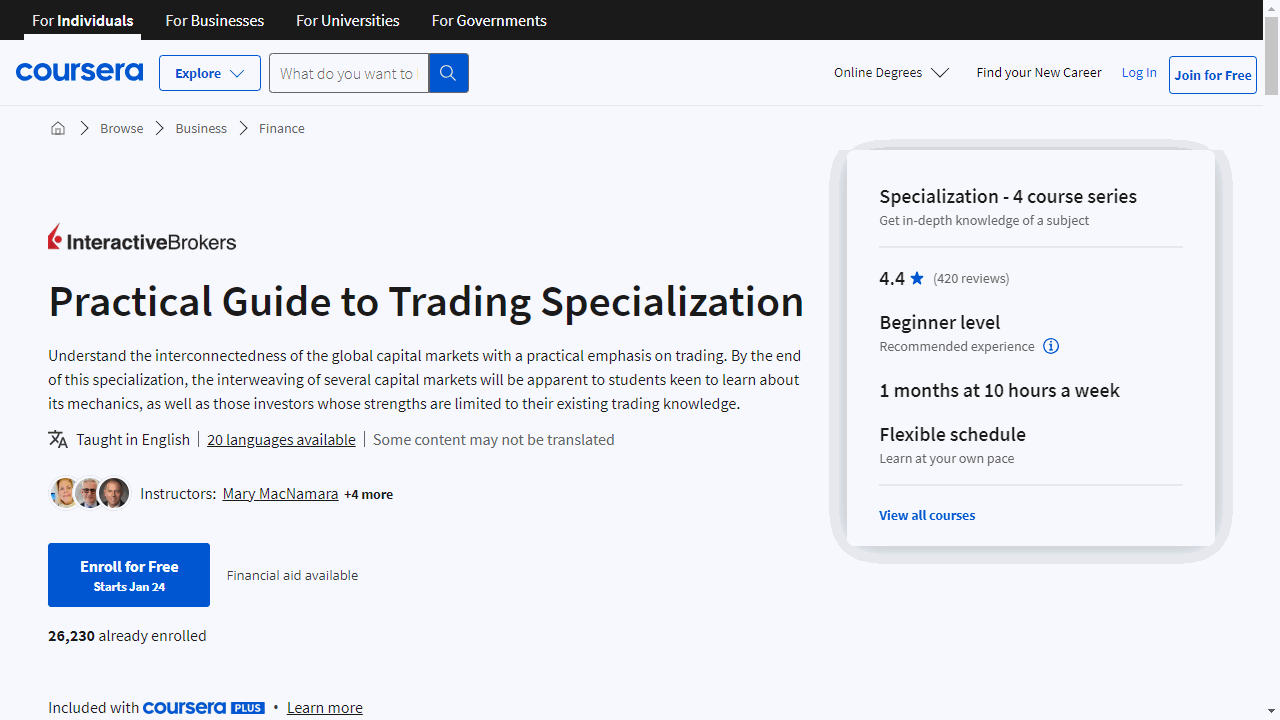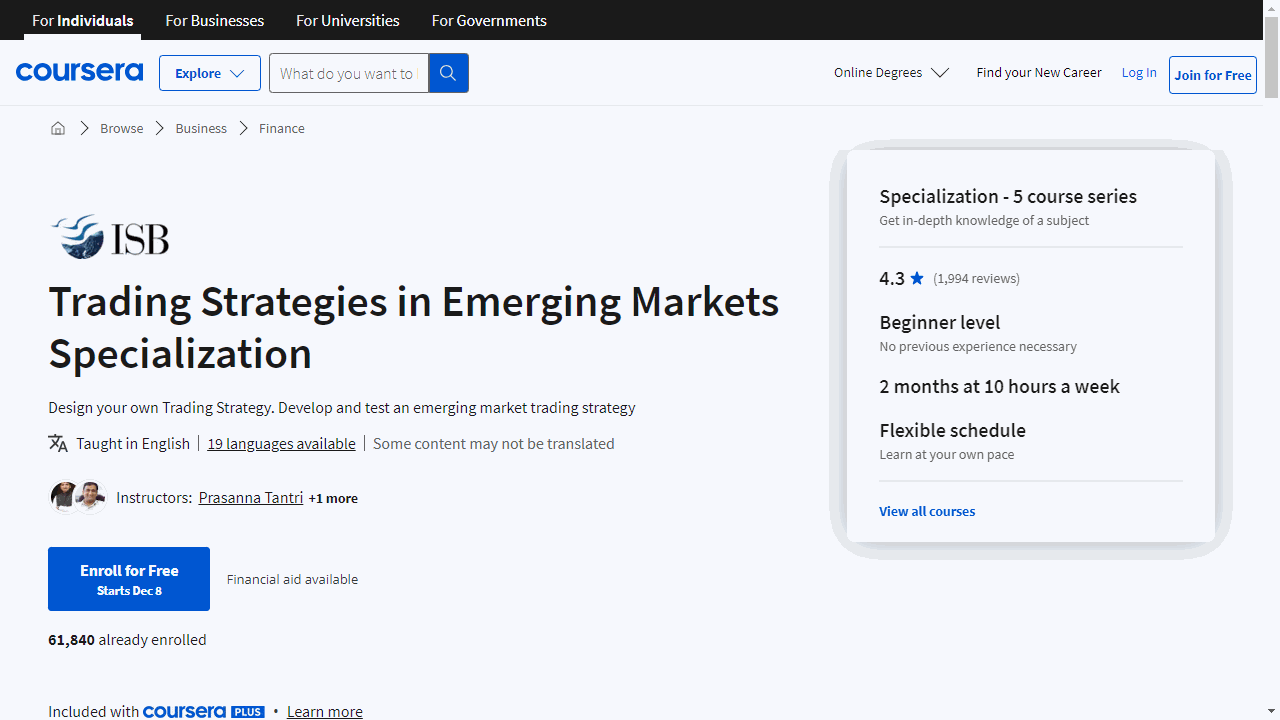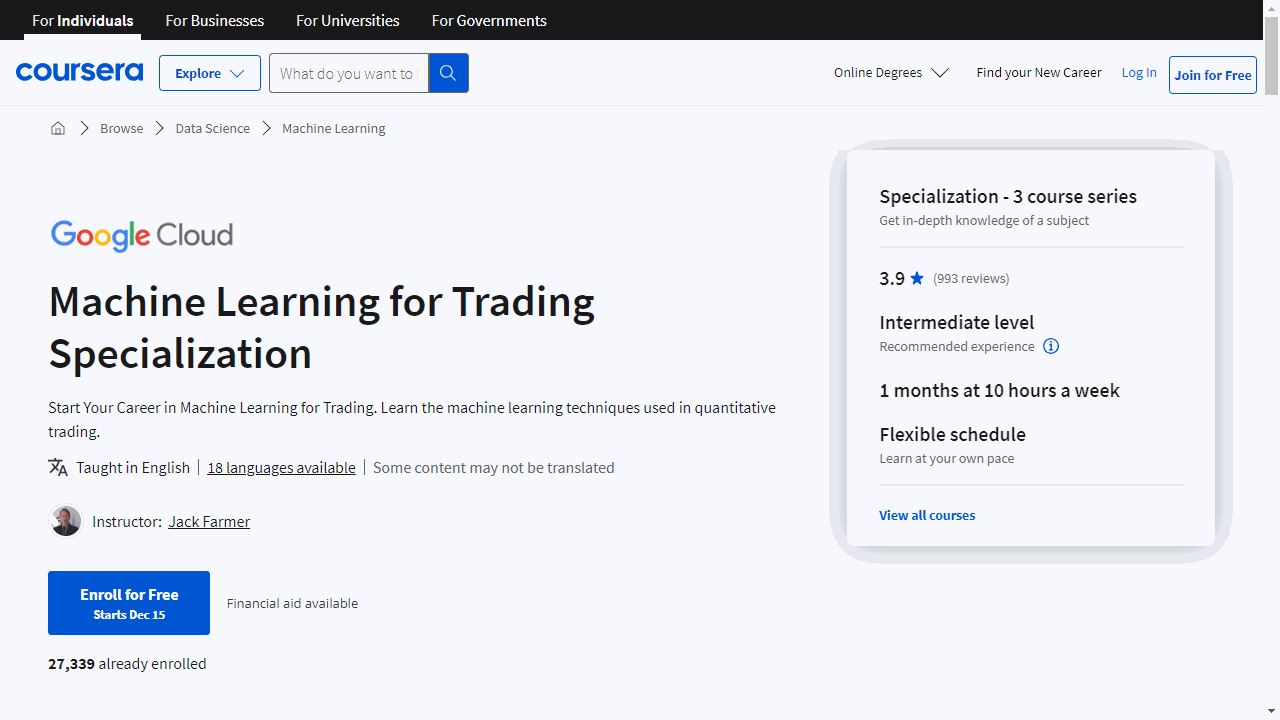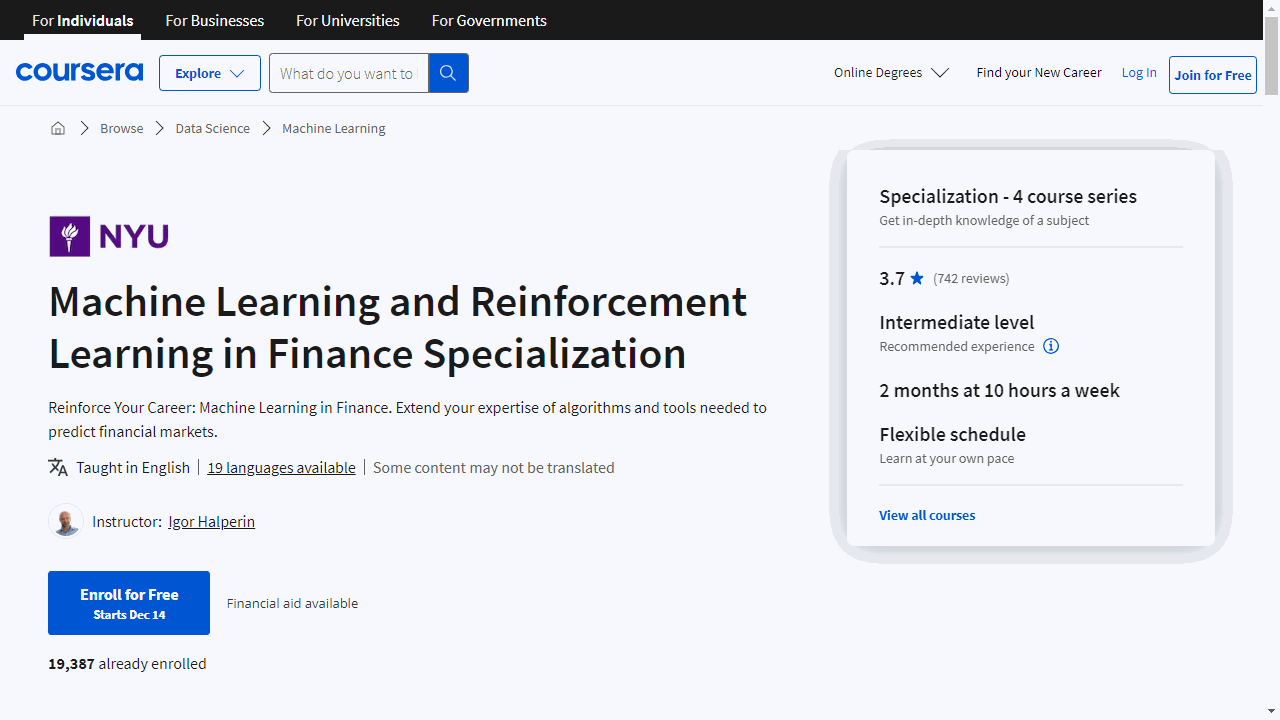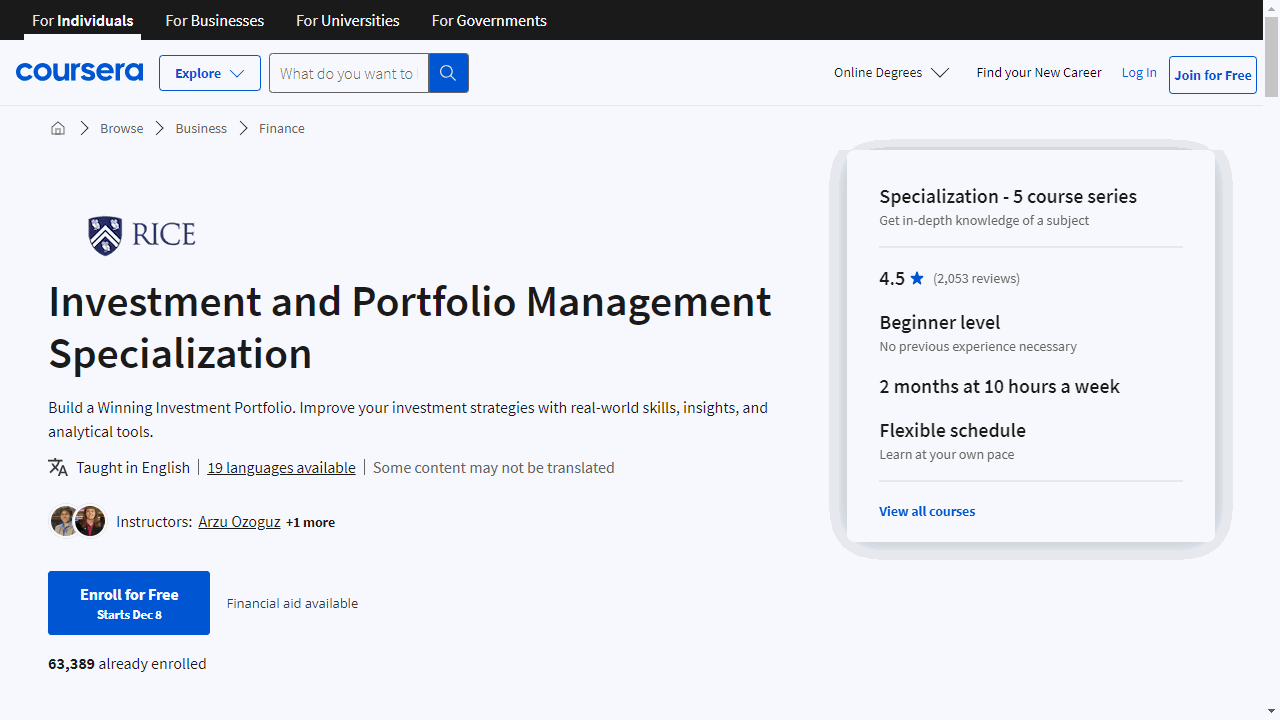Trading is a dynamic and complex field that involves the buying and selling of financial assets, ranging from stocks and bonds to currencies and commodities.
Mastering the art of trading requires a deep understanding of market mechanics, financial instruments, and effective trading strategies.
By learning to navigate the intricacies of the financial world, you can potentially prepare for a career as a trader, portfolio manager, or financial analyst.
Finding a top-notch trading course on Coursera can feel overwhelming with so many options available.
You’re likely seeking a program that provides a comprehensive overview of trading concepts, equips you with practical skills, and guides you through the complexities of the market.
For the best overall trading course on Coursera, we recommend the "Practical Guide to Trading Specialization" by Interactive Brokers.
This program covers the essentials of trading across various asset classes, including equities, Forex, bonds, and derivatives.
It provides a robust foundation in fundamental analysis, technical analysis, and risk management, preparing you for real-world trading scenarios.
The specialization’s emphasis on practical examples, quizzes, and projects ensures that you gain both knowledge and hands-on experience, making it a valuable resource for aspiring traders.
While this specialization stands out as our top pick, there are other excellent trading courses available on Coursera.
Explore our recommendations for various learning levels, specific asset classes, and advanced trading strategies to find the perfect course for your journey.
Practical Guide to Trading Specialization
Provider: Interactive Brokers
This is a comprehensive program that covers the essentials of trading across various asset classes.
In “Fundamentals of Equities,” you’ll dive into the stock market, learning to analyze industries, economic sectors, and fundamental values.
You’ll become adept at interpreting balance sheets, cash flows, and income statements.
This course also introduces you to mutual funds and ETFs, providing a broader investment perspective.
“Forex - Trading Around the World” offers a thorough understanding of the foreign exchange market (FOREX).
You’ll explore the roles of its participants, the intricacies of currency pairs, and the use of margin accounts.
Practical skills in executing trades on an online trading platform are a key takeaway, setting you up for real-world currency trading.
For a solid grasp of the fixed income space, “U.S. Bond Investing Basics” is your go-to.
You’ll differentiate between corporate and municipal bonds, understand the mechanics of the bond market, and identify investment risks.
The course equips you with the know-how to navigate an online trading platform for bond transactions.
Lastly, “Derivatives - Options & Futures” demystifies complex financial instruments.
You’ll learn the language of stock options, the mechanics of the futures market, and strategies for trading options.
The course emphasizes practical demonstrations, helping you to comprehend and apply options and futures concepts.
Each course is designed with practical examples, quizzes, and projects, ensuring you not only learn but also apply your knowledge.
For hands-on practice, you can use a demo trading account to simulate trading in a risk-free environment.
By completing this specialization, you’ll acquire the skills to analyze and trade in equities, FOREX, bonds, and derivatives with confidence.
Trading Strategies in Emerging Markets Specialization
This specialization is offered by Indian School of Business.
It offers a deep dive into the mechanics of trading, specifically designed for the dynamic emerging markets.
Kick off with “Trading Basics,” where you’ll get to grips with financial statements and the inner workings of the stock market.
This course empowers you to analyze company performance and craft trading strategies informed by academic research.
You’ll also tackle asset pricing theories to predict stock returns and understand the intricacies of asset markets, including order types, trading costs, and liquidity management.
Move on to “Trading Algorithms,” where you’ll focus on two powerful strategies: the Piotroski F-score and Post-Earnings-Announcement Drift (PEAD).
You’ll learn to navigate academic research and apply these strategies effectively, enhancing your trading acumen.
With “Advanced Trading Algorithms,” you’ll refine your strategy development with robust backtesting, avoiding common pitfalls like look-ahead and survival bias.
This course teaches you to incorporate transaction costs into your algorithms and evaluate strategy performance using measures like the Sharpe ratio, Treynor’s Ratio, and Jensen’s Alpha.
“Creating a Portfolio” brings your learning full circle by showing you how to assemble a portfolio of strategies fit for a hedge fund.
You’ll master risk and return assessment, optimal strategy weighting, and risk minimization techniques.
A bonus is the overview of hedge fund regulations and investor expectations.
The capstone, “Design your own trading strategy – Culminating Project,” is where you shine.
You’ll create and evaluate new trading strategies, integrate them into a portfolio, and draft a plan to start your hedge fund.
This specialization equips you with skills in financial analysis, algorithmic trading, and risk management.
Machine Learning for Trading Specialization
Provider: New York Institute of Finance, Google Cloud
This set of courses is a practical deep dive into applying machine learning to the world of finance and trading.
Kick off with “Introduction to Trading, Machine Learning & GCP” to master trading basics like trends and volatility.
You’ll also learn to craft quantitative trading strategies and use machine learning to predict market movements.
The course leverages Google Cloud Platform and Jupyter Notebooks, giving you hands-on experience in building financial models.
You should come prepared with advanced Python knowledge and a solid foundation in statistics and financial markets.
Familiarity with machine learning libraries such as Scikit-Learn is also crucial.
The second course, “Using Machine Learning in Trading and Finance,” steps up the game.
It’s all about developing sophisticated trading strategies with machine learning.
You’ll get to grips with pairs trading and momentum trading, and use Keras and TensorFlow to create and test your own models.
The final course, “Reinforcement Learning for Trading Strategies,” introduces you to the cutting-edge world of reinforcement learning.
Discover how to integrate neural networks with reinforcement learning, apply LSTMs to time series data, and develop trading strategies that learn and adapt.
Each course builds on the last, ensuring you develop a robust understanding of both machine learning and trading.
By the end, you’ll be equipped to build, test, and optimize trading strategies using the latest AI techniques.
Financial Engineering and Risk Management Specialization
If you are interested in modeling financial derivatives, this specialization by Columbia University is a solid choice.
The specialization begins with the “Introduction to Financial Engineering and Risk Management” course.
This foundational course equips you with the mathematical tools necessary for financial analysis, covering probability, optimization, and the valuation of various financial instruments.
You’ll learn to calculate present value in an arbitrage-free environment and price options using models like Binomial and Black-Scholes.
It’s a solid starting point that prepares you for more advanced topics.
Moving on, “Term-Structure and Credit Derivatives” delves into the behavior of interest rates and the mechanics of credit markets.
You’ll explore how to model the evolution of interest rates and gain insights into instruments like credit default swaps and mortgage-backed securities.
The course also includes practical exercises, such as using Excel for model calibration, ensuring that you can apply your knowledge to real-world scenarios.
For those interested in asset management, “Optimization Methods in Asset Management” offers a deep dive into portfolio construction and risk assessment.
You’ll learn about the Capital Asset Pricing Model (CAPM) and other techniques to optimize investment portfolios, considering factors like transaction costs and market liquidity.
This course emphasizes the application of theory to practice, preparing you to handle the complexities of asset management.
“Advanced Topics in Derivative Pricing” is designed for those ready to tackle more sophisticated financial concepts.
You’ll get to grips with the Black-Scholes model, learn about the Greeks and their role in risk management, and explore the intricacies of volatility in the markets.
The course also examines the impact of credit derivatives on the financial system, providing a well-rounded understanding of derivative pricing.
Lastly, “Computational Methods in Pricing and Model Calibration” merges finance with computational techniques.
You’ll be introduced to various options and pricing methods, including the use of Fourier Transforms.
The course is hands-on, with Python coding exercises that allow you to practice pricing options and calibrating models, giving you a skill set that’s highly valued in the finance industry.
By the end of the specialization, you’ll have a diverse set of skills, from understanding derivatives and fixed income instruments to mastering computational methods in finance.
Machine Learning and Reinforcement Learning in Finance Specialization
Provider: New York University
This specialization is a practical journey into the intersection of machine learning and finance, offering a clear path from foundational concepts to advanced applications.
Kick off with the “Guided Tour of Machine Learning in Finance,” where you’ll grasp the essentials of ML and its financial applications.
If you’re a finance professional, a day trader, or a student in a related field, this course is your gateway.
You’ll need familiarity with Python, linear algebra, and basic calculus to tackle the assignments.
Progress to the “Fundamentals of Machine Learning in Finance” to deepen your understanding of supervised, unsupervised, and reinforcement learning.
You’ll get to grips with Python’s ML tools and apply unsupervised learning to a portfolio trading strategy.
This course builds on the first, sharpening your problem-solving skills.
The third course, “Reinforcement Learning in Finance,” is where your skills start to pay off.
You’ll delve into RL’s core concepts and apply them to finance’s big questions like portfolio optimization and option pricing.
Get ready to engage with Q-learning and model market dynamics.
Prior completion of the first two courses will set you up for success here.
Conclude with the “Overview of Advanced Methods of Reinforcement Learning in Finance,” where you’ll explore the advanced territory, including the links between RL, option pricing, and physics.
You’ll also discover how to apply RL to high-frequency trading and cryptocurrencies.
This course will leave you equipped to discuss complex financial concepts and apply RL to diverse financial scenarios.
Throughout this specialization, you’ll develop skills in Python, including Jupyter notebooks, and master key concepts such as risk management and trading strategies.
You’ll also touch on the forefront of finance, including cryptocurrencies and peer-to-peer lending.
Investment and Portfolio Management Specialization
This comprehensive program offered by Rice University equips you with the tools to navigate financial markets with confidence.
Start with “Global Financial Markets and Instruments” to grasp the essentials of financial assets and markets.
You’ll learn about the roles of different financial instruments, delve into algorithmic trading, and understand market operations.
By the end, you’ll confidently list and compare various investment vehicles.
In “Portfolio Selection and Risk Management,” you’ll master the art of constructing an optimal portfolio and managing investment risks.
This course empowers you to analyze risk-return trade-offs and apply equilibrium asset pricing models, ensuring you make informed asset allocation decisions.
“Biases and Portfolio Selection” tackles the psychological side of investing.
You’ll uncover common behavioral biases and learn strategies to mitigate their impact on investment decisions.
This insight is crucial for maintaining a clear head in the often-irrational financial markets.
Move on to “Investment Strategies and Portfolio Analysis” to get up to speed with the latest investment strategies and performance evaluation techniques.
You’ll explore various approaches to investing and learn how to assess the effectiveness of different portfolio strategies.
The “Capstone: Build a Winning Investment Portfolio” is where theory meets practice.
You’ll manage a simulated investment portfolio and provide advice to virtual clients, using advanced analytical tools.
This real-world experience is a powerful way to demonstrate your investment acumen.
Throughout the specialization, you’ll engage with key concepts like bond valuation, modern portfolio theory, and risk management.
You’ll also become familiar with financial terms such as Treasury securities, derivative instruments, and mortgage-backed securities.
